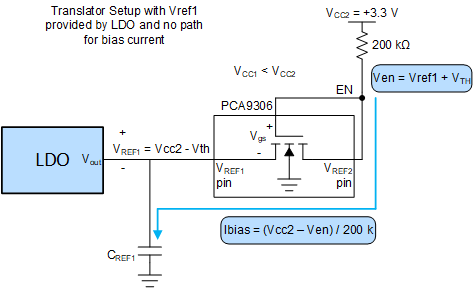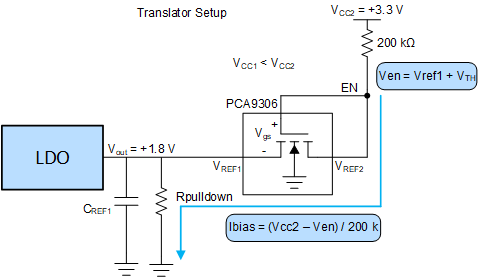ZHCSJK2O October 2004 – September 2023 PCA9306
PRODUCTION DATA
- 1
- 1 特性
- 2 应用
- 3 说明
- 4 Revision History
- 5 Pin Configuration and Functions
-
6 Specifications
- 6.1 Absolute Maximum Ratings
- 6.2 ESD Ratings
- 6.3 Recommended Operating Conditions
- 6.4 Thermal Information
- 6.5 Electrical Characteristics
- 6.6 Switching Characteristics AC Performance (Translating Down) (EN = 3.3 V)
- 6.7 Switching Characteristics AC Performance (Translating Down) (EN = 2.5 V)
- 6.8 Switching Characteristics AC Performance (Translating Up) (EN = 3.3 V)
- 6.9 Switching Characteristics AC Performance (Translating Up) (EN = 2.5 V)
- 6.10 Typical Characteristics
- 7 Parameter Measurement Information
-
8 Detailed Description
- 8.1
Overview
- 8.1.1 Definition of threshold voltage
- 8.1.2 Correct Device Set Up
- 8.1.3 Disconnecting an I2C target from the Main I2C Bus Using the EN Pin
- 8.1.4 Supporting Remote Board Insertion to Backplane with PCA9306
- 8.1.5 Switch Configuration
- 8.1.6 Controller on Side 1 or Side 2 of Device
- 8.1.7 LDO and PCA9306 Concerns
- 8.1.8 Current Limiting Resistance on VREF2
- 8.2 Functional Block Diagram
- 8.3 Feature Description
- 8.4 Device Functional Modes
- 8.1
Overview
- 9 Application and Implementation
- 10Power Supply Recommendations
- 11Layout
- 12Device and Documentation Support
- Mechanical, Packaging, and Orderable Information
封装选项
机械数据 (封装 | 引脚)
散热焊盘机械数据 (封装 | 引脚)
订购信息
8.1.7 LDO and PCA9306 Concerns
The VREF1 pin can be supplied by a low-dropout regulator (LDO), but in some cases the LDO may lose its regulation because of the bias current from VREF2 to VREF1. If the LDO cannot sink the bias current, then the current has no other paths to ground and instead charges up the capacitance on the VREF1 node (both external and parasitic). This results in an increase in voltage on the VREF1 node. If no other paths for current to flow are established (such as back biasing of body diodes or clamping diodes through other devices on the VREF1 node), then the VREF1 voltage ends up stabilizing when Vgs of the pass FET is equal to Vth. This means VREF1 node voltage is VCC2 - Vth. Note that any targets/controllers running off of the LDO now see the VCC2 - Vth voltage which may cause damage to those targets/controllers if they are not rated to handle the increased voltage.
 Figure 8-8 Example of no leakage current path when using LDO
Figure 8-8 Example of no leakage current path when using LDOTo make sure the LDO does not lose regulation due to the bias current of PCA9306, a weak pull down resistor can be placed on VREF1 to ground to provide a path for the bias current to travel. The recommended pull down resistor is calculated by Equation 4 where 0.75 gives about 25% margin for error incase bias current increases during operation.
 Figure 8-9 Example with Leakage current path when using an LDO
Figure 8-9 Example with Leakage current path when using an LDOwhere
- Vth is approximately 0.6 V